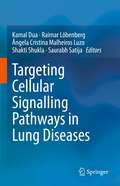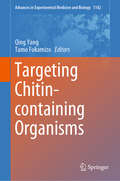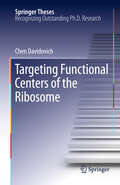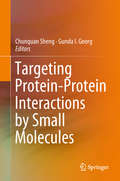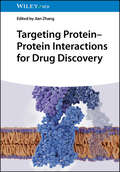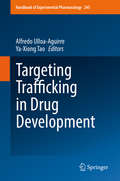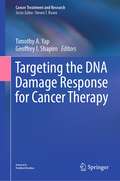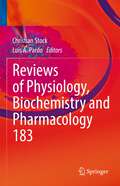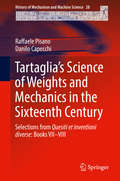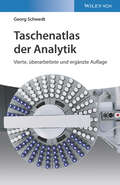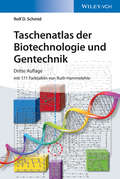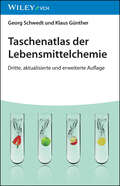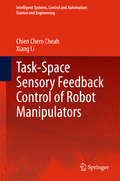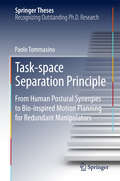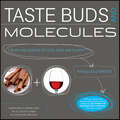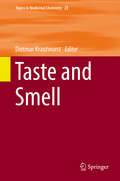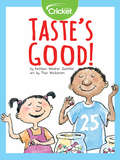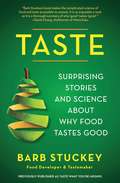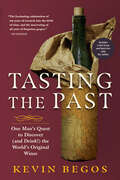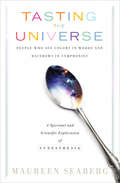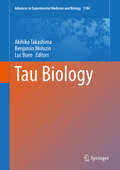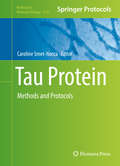- Table View
- List View
Targeting Cellular Signalling Pathways in Lung Diseases
by Shakti Shukla Kamal Dua Raimar Löbenberg Ângela Cristina Malheiros Luzo Saurabh SatijaThe book comprehensively reviews and provides detailed insight into the cellular and molecular signalling mechanisms involved in pathophysiology of various respiratory diseases, towards developing effective therapeutic strategies in the management and treatment of lung disease. It also covers promising advances in the field of therapeutics that could lead to novel clinical therapies capable of preventing or reversing the disease features including novel strategies for targeting chronic lung diseases using advanced drug delivery systems. Importantly, the book examines the significance and relevance of the plant extracts and their constituents with therapeutic efficiencies against lung diseases. As such, the book offers a blend of translational, biological, chemical, and drug delivery aspects relevant to respiratory diseases, thus, offering a valuable resource for pulmonologists and translational researchers working in the field of pulmonary biology and respiratory medicine.
Targeting Chitin-containing Organisms (Advances in Experimental Medicine and Biology #1142)
by Qing Yang Tamo FukamizoThis book provides a comprehensive overview of chitin biology and chitin metabolism related enzymes. Chitin, the second most abundant biopolymer in nature after to cellulose, is a linear biopolymer composed of β-1,4-linked N-acetylglucosamine (GlcNAc), and an essential component in the exoskeletons of insects, mites, ticks and crustaceans, the egg shells of parasitic nematodes, and fungal cell walls. Although some chitin-containing organisms are a threat to human health, food safety and agricultural production, non-chitin containing organisms like humans, mammals and plants have an innate immune response to these hazardous organisms. The book provides researchers and students with information on the recent research advances concerning the biology of chitin-containing organisms as well as cross-talks between chitin-containing and non-chitin-containing organisms. Highlighting chitin remodeling enzymes and inhibitors, it also offers drug developers essential insights into designing specific molecules for the control of hazardous chitin-containing organisms.
Targeting Enzymes for Pharmaceutical Development: Methods and Protocols (Methods in Molecular Biology #2089)
by Nikolaos E. LabrouThis volume explores detailed methods and experimental protocols evaluating the effect of a compound or a mixture of compounds on the action of enzymes that are significant targets in pharmaceuticals. Consisting of three sections, the book delves into recent biocomputing and bioinformatics protocols, state-of-the art modern biophysical, electrophoretic, and chromatographic methods and high-throughput screening approaches, as well as detailed protocols and examples of the inhibition analysis and evaluation of selected enzymes. Written for the highly successful Methods in Molecular Biology series, chapters include introductions to their respective topics, lists of the necessary materials and reagents, step-by-step, readily reproducible laboratory protocols, and tips on troubleshooting and avoiding known pitfalls. Authoritative and cutting-edge, Targeting Enzymes for Pharmaceutical Development: Methods and Protocols serves as a vital reference for academics and industry professionals working on expanding our understanding of the wide range of important enzyme targets.
Targeting Epigenetics in Inflammatory Lung Diseases
by Gaurav Gupta Kamal Dua Brian G. Oliver Md Khadem Ali Piyush DaveThis book discusses the role of epigenetics in pathogenesis of different pulmonary diseases, including chronic obstructive pulmonary disease, lung cancer, pulmonary tuberculosis, idiopathic pulmonary fibrosis and pulmonary infections. It also explores post-translational modifications in DNA and histones for improving the understanding of lung diseases. This book helps in understanding the epigenetic mechanisms towards the development of novel diagnostic and therapeutic approaches. Further, the book provides insight into the underlying molecular mechanisms involved in the epigenetic regulation of inflammation, which may have novel implications in designing small molecule inhibitors that target the epigenetic machinery for the effective treatment of a variety of inflammation‑related diseases. This book is a valuable resource for academics, research and industry professionals working in respiratory biology.
Targeting Functional Centers of the Ribosome
by Chen DavidovichThis thesis describes research into the mode of function, inhibition, and evolution of the ribosomal catalytic center, the Peptidyl Transferase Center (PTC)--research that has already led to attempts at improving PTC antibiotics. The PhD candidate carried out two parallel studies. One using a combination of X-ray crystallography, biochemistry, molecular biology, and theoretical studies to obtain crystal structures of ribosomal particles with antibiotics that target the PTC, revealing the modes of action, resistance, cross-resistance and discrimination between ribosomes of eubacterial pathogens and eukaryotic hosts. In the second parallel study, the candidate synthesized a ribosomal substructure--one that may represent the minimal entity capable of catalyzing peptide bond formation--shedding light on the origin of the ribosome itself.
Targeting Protein-Protein Interactions by Small Molecules
by Chunquan Sheng Gunda I. GeorgThis book comprehensively reviews the state-of-the-art strategies developed for protein-protein interaction (PPI) inhibitors, and highlights the success stories in new drug discovery and development. Consisting of two parts with twelve chapters, it demonstrates the design strategies and case studies of small molecule PPI inhibitors. The first part discusses various discovery strategies for small molecule PPI inhibitors, such as high throughput screening, hot spot-based design, computational approaches, and fragment-based design. The second part presents recent advances in small molecule inhibitors, focusing on clinical candidates and new PPI targets. This book has broad appeal and is of significant interest to the pharmaceutical science and medicinal chemistry communities.
Targeting Protein-Protein Interactions for Drug Discovery
by Jian ZhangUp-to-date reference surveying the latest advances in the structural understanding of protein-protein interactions and developments in drug discovery and therapeutics Targeting Protein–Protein Interactions for Drug Discovery provides a systematic and comprehensive overview of protein-protein interactions (PPIs), reviewing foundational concepts, advanced methodologies, and emerging therapeutic strategies, reflecting the multidisciplinary nature of PPI research. This book discusses computational methods for predicting PPI structures, with a special emphasis on protein docking and deep learning-based approaches, diverse chemical scaffolds for PPI modulation, including foldamers as inhibitors of aberrant PPIs and sulfonyl-γ-AApeptides as novel modulators, and the development and application of stapled peptides as modulators of intracellular PPIs, offering enhanced stability, binding affinity, and cellular permeability. Readers will also find information on cyclic peptides, focusing on their unique conformational stabilization and therapeutic potential across a range of diseases, small molecule inhibitors targeting BCL-family proteins, revealing their potential in cancer therapy, molecular glues as activators for PPIs, categorized into degraders, stabilizers, and inhibitors based on their biological effects, and the targeting of the APC–Asef interaction for drug discovery in colorectal cancer therapy, offering a case study of specificity and clinical relevance. Targeting Protein–Protein Interactions for Drug Discovery explores sample topics including: Challenges and strategies of drug discovery targeting PPIs, including high-throughput screening and structure-based drug design Fluorescence resonance energy transfer (FRET) technology, a powerful tool for real-time analysis of molecular interactions in live cells Utility of mass spectrometry (MS) for large-scale mapping of PPI networks with high sensitivity and resolution Proximity ligation assays (PLA) for detecting PPIs in situ, emphasizing spatial precision and adaptability for multiplexed detection Application of surface plasmon resonance (SPR) for characterizing PPI specificity, affinity, and kinetics Exploring both classical and novel approaches to PPI characterization and modulation, Targeting Protein–Protein Interactions for Drug Discovery offers a comprehensive reference for researchers aiming to unlock the therapeutic potential of PPIs along with educators and students engaged in the study of cellular mechanisms, drug discovery, and biotechnology.
Targeting Trafficking in Drug Development (Handbook of Experimental Pharmacology #245)
by Alfredo Ulloa-Aguirre Ya-Xiong TaoCellular trafficking is only recently identified as a site for therapeutic intervention. This book provides up to date information on the mechanism for exploiting this area for drug development as well as a clear understanding of the individual components of cellular trafficking. The authors are experts in their areas and the book features tables and figures that enable comparison and clear understanding.
Targeting the DNA Damage Response for Cancer Therapy (Cancer Treatment and Research #186)
by Timothy A. Yap Geoffrey I. ShapiroThis book discusses the latest developments in Poly (ADP-ribose) polymerase (PARP) inhibitor drug development. It focuses on the translational and clinical development of the latest drugs, as well as the evidence for regulatory approval of PARP inhibitors in multiple different molecular subtypes and tumor indications. The most-up-to-date information on basic scientific research on DNA repair pathways and the DNA Damage Response (DDR) is also covered. Every chapter contains insight into the preclinical, translational along with clinical aspects of a specific DDR inhibitor with key and expert opinion points reinforcing the most important concepts detailed to enable the reader to develop a deep understanding of the topic.Targeting the DNA Damage Response for Cancer Therapy comprehensively reviews the application of PARP and other DDR inhibitors across oncology disciplines. Therefore, it is a valuable resource for all medical professionals and researchers who use or who are researching the use of these inhibitors on a day-to-day basis.
Targets of Cancer Diagnosis and Treatment: Ion Transport in Tumor Biology (Reviews of Physiology, Biochemistry and Pharmacology #183)
by Christian Stock Luis A. PardoThis third and final volume in the "Ion Transport in Tumor Biology" collection presents novel diagnostic and therapeutic approaches in cancer based on the exploitation of ion transport proteins. The authors critically examine several transportome members, particularly Na+, K+, Ca2+, and Cl- channels, as well as organic solute carriers regarding their suitability as therapeutic targets. Synergistic effects resulting from the combined use of classical cytostatics with ion transport-inhibiting drugs are pointed out, and the capability of bispecific antibodies to function as anticancer drugs is discussed. As readers will also learn, the use of ion channel inhibitors could improve the outcome of radiotherapy because the development of radio-resistance during radiotherapeutic treatment often correlates with increases in the expression levels and conductance of ion channels. The translational topics of this volume form a bridge between biochemical research and therapeutic application. As part of a three-volume collection, this book will fascinate members of the active research community, as well as clinicians in the cancer field.
Tartaglia’s Science of Weights and Mechanics in the Sixteenth Century
by Raffaele Pisano Danilo CapecchiThis book presents a historical and scientific analysis as historical epistemology of the science of weights and mechanics in the sixteenth century, particularly as developed by Tartaglia in his Quesiti et inventioni diverse, Book VII and Book VIII (1546; 1554). In the early 16th century mechanics was concerned mainly with what is now called statics and was referred to as the Scientia de ponderibus, generally pursued by two very different approaches. The first was usually referred to as Aristotelian, where the equilibrium of bodies was set as a balance of opposite tendencies to motion. The second, usually referred to as Archimedean, identified statics with centrobarica, the theory of centres of gravity based on symmetry considerations. In between the two traditions the Italian scholar Niccolò Fontana, better known as Tartaglia (1500?-1557), wrote the treatise Quesiti et inventioni diverse (1546). This volume consists of three main parts. In the first, a historical excursus regarding Tartaglia's lifetime, his scientific production and the Scientia de ponderibus in the Arabic-Islamic culture, and from the Middle Ages to the Renaissance, is presented. Secondly, all the propositions of Books VII and VIII, by relating them with the Problemata mechanica by the Aristotelian school and Iordani opvsculvm de ponderositate by Jordanus de Nemore are examined within the history and historical epistemology of science. The last part is relative to the original texts and critical transcriptions into Italian and Latin and an English translation. This work gathers and re-evaluates the current thinking on this subject. It brings together contributions from two distinguished experts in the history and historical epistemology of science, within the fields of physics, mathematics and engineering. It also gives much-needed insight into the subject from historical and scientific points of view. The volume composition makes for absorbing reading for historians, epistemologists, philosophers and scientists.
Taschenatlas der Analytik
by Georg SchwedtDer Taschenatlas bietet eine kompakte Einführung und Übersicht über Grundlagen und Anwendungen der Analytischen Chemie. Dabei sind jeweils erläuternder Text und eine Farbtafel auf einer Doppelseite gegenübergestellt. Das Buch enthält insgesamt 125 Farbtafeln, die die gesamte Breite der modernen Analytik in Chemie, Biowissenschaften und Teilen von Physik und Materialwissenschaften abdecken. Für die vierte Auflage wurde der Taschenatlas erweitert und auf den aktuellen Stand gebracht. Er enthält u. a. acht neue Farbtafeln zu aktuellen Themen wie Mikroextraktionstechniken, Radioimmunoassays, Superfluid-Chromatographie und die elektronenmikroskopische Untersuchung von Materialoberflächen. Mit diesem Atlas sind die Grundlagen aller wichtigen analytischen Verfahren immer griffbereit - ideal zum raschen Nachlesen und für die Prüfungsvorbereitung.
Taschenatlas der Biotechnologie und Gentechnik
by Rolf D. Schmid Ruth HammelehleDer Taschenatlas der Biotechnologie und Gentechnik hat seit dem ersten Erscheinen 2001 bereits etliche Jahrgänge von Studenten und Schülern und interessierte Quereinsteiger in die Grundlagen diese wegweisenden Zukunftstechnologien eingeführt und sich als anschaulicher und unersetzlicher Begleiter etabliert. Biotechnologie und Gentechnik gelten als Schlüsseltechnologien des 21. Jahrhunderts. Sie sind Motor für die Erforschung und Entwicklung neuer Arzneimittel und Therapieformen, von Nutzpflanzen und Lebensmittel sowie von modernen Umwelttechnologien und innovativen industriellen Verfahren. Diese neue Auflage wurde grundlegend aktualisiert sowie um die Themen Tissue Engineering, Protein Design und Proteomics erweitert. Der neue Atlas wird damit weiterhin seiner Rolle als reichhaltige und aktuelle Quelle zu den spannendsten Themen innerhalb dieses wichtigen Forschungszweiges gerecht. aus einer Rezension der 1. Auflage: "... Der Atlas ist Studenten der Naturwissenschaften und der Medizin ebenso zu empfehlen wie allen, die einen Überblick über Produkte, Methoden, Anwendungen sowie wirtschaftliche und rechtliche Rahmenbedingungen der Bio- und Gentechnologie suchen." Chemie in unserer Zeit
Taschenatlas der Lebensmittelchemie
by Georg Schwedt Klaus GüntherTaschenatlas der Lebensmittelchemie Der Taschenatlas bietet eine kompakte Einführung und Übersicht zu Grundlagen und Einsatzgebieten der Lebensmittelchemie. Dabei sind jeweils erläuternder Text und eine Farbtafel auf einer Doppelseite gegenübergestellt. Das Buch enthält insgesamt 128 Farbtafeln, die die gesamte Breite der modernen Lebensmittelchemie abdecken, von Inhaltsstoffen und Schadstoffen in Lebensmitteln über deren Verarbeitung bis hin zu Risiken und rechtlichen Grundlagen der Lebensmittelproduktion. Für die dritte Auflage wurde der Taschenatlas deutlich erweitert und durchgehend aktualisiert. Er enthält zahlreiche neue Farbtafeln zu aktuellen Themen wie Nahrungsergänzungsmittel, Fleischersatz, Nanotechnologie und den Auswirkungen der Lebensmittelproduktion auf das Klima. Mit diesem Atlas sind die Grundlagen der Lebensmittelchemie und ihrer Verfahren immer griffbereit – ideal zum raschen Nachlesen und für die Prüfungsvorbereitung.
Task-Space Sensory Feedback Control of Robot Manipulators (Intelligent Systems, Control and Automation: Science and Engineering #73)
by Xiang Li Chien Chern CheahThis book presents recent advances in robot control theory on task space sensory feedback control of robot manipulators. By using sensory feedback information, the robot control systems are robust to various uncertainties in modelling and calibration errors of the sensors. Several sensory task space control methods that do not require exact knowledge of either kinematics or dynamics of robots, are presented. Some useful methods such as approximate Jacobian control, adaptive Jacobian control, region control and multiple task space regional feedback are included. These formulations and methods give robots a high degree of flexibility in dealing with unforeseen changes and uncertainties in its kinematics and dynamics, which is similar to human reaching movements and tool manipulation. It also leads to the solution of several long-standing problems and open issues in robot control, such as force control with constraint uncertainty, control of multi-fingered robot hand with uncertain contact points, singularity issue of Jacobian matrix, global task-space control, which are also presented in this book. The target audience for this book includes scientists, engineers and practitioners involved in the field of robot control theory.
Task-space Separation Principle: From Human Postural Synergies To Bio-inspired Motion Planning For Redundant Manipulators (Springer Theses)
by Paolo TommasinoThis book addresses two fundamental issues of motor control for both humans and robots: kinematic redundancy and the posture/movement problem. It blends traditional robotic constrained-optimal approaches with neuroscientific and evidence-based principles, proposing a “Task-space Separation Principle,” a novel scheme for planning both posture and movement in redundant manipulators. The proposed framework is first tested in simulation and then compared with experimental motor strategies displayed by humans during redundant pointing tasks. The book also shows how this model builds on and expands traditional formulations such as the Passive Motion Paradigm and the Equilibrium Point Theory. Lastly, breaking with the neuroscientific tradition of planar movements and linear(ized) kinematics, the theoretical formulation and experimental scenarios are set in the nonlinear space of 3D rotations which are essential for wrist motions, a somewhat neglected area despite its importance in daily tasks.
Taste Buds and Molecules: The Art and Science of Food and Wine
by Francois ChartierWhat's the secret relationship between the strawberry and the pineapple? Between mint and Sauvignon Blanc? Thyme and lamb? Rosemary and Riesling?In Taste Buds and Molecules, sommelier François Chartier, who has dedicated over twenty years of passionate research to the molecular relationships between wines and foods, reveals the fascinating answers to these questions and more. With an infectious enthusiasm, Chartier presents a revolutionary way of looking at food and wine, showing how to create perfect harmony between the two by pairing complementary (and often surprising) ingredients. The pages of this richly illustrated practical guide are brimming with photos, sketches, recipes from great chefs, and tips for creating everything from simple daily meals to tantalizing holiday feasts.Wine amateurs and connoisseurs, budding cooks and professional chefs, and anyone who simply loves the pleasures of eating and drinking will be captivated and charmed by this journey into the hidden world of flavours.
Taste Buds and Molecules: The Art and Science of Food, Wine, and Flavor
by Francois Chartier"If Catalan superchef Ferran Adria is the leading missionary of molecular gastronomy, Mr. Chartier is his counterpart with a corkscrew."—Globe and MailThis award-winning book, now available for the first time in English in the U.S., presents a cutting-edge approach to food and wine pairing. Sommelier Francois Chartier has spent the better part of two decades collaborating with top scientists and chefs to map out the aromatic molecules that give foods and wines their flavor. Armed with the results of his extensive research, Chartier has been able to identify why certain foods and wines work well together at a molecular level. In this book, he has gathered his findings into a simple set of principles that explain how to create ideal harmonies in food and wine pairings. This new approach to the art and science of food and wine pairing will be an invaluable resource for sommeliers, chefs, and wine enthusiasts, as well as a fascinating read for anyone who is interested in the principles of modernist or "molecular" cuisine. The Canadian edition of Taste Buds and Molecules was a 2011 IACP Award nominee, and the original French-language edition, Papilles et Molecules, was named the Best Cookbook in the World in the category of Innovation at the 2010 Paris World Cookbook Awards, and also won the 2010 Gourmand Award for Canada for Best Design. The book includes a foreword by Juli Soler and Ferran Adria of El Bulli, who worked closely with Chartier in planning the menus at their renowned restaurant.
Taste and Smell
by Dietmar KrautwurstMedicinal chemistry is both science and art. The science of medicinal chemistry offers mankind one of its best hopes for improving the quality of life. The art of medicinal chemistry continues to challenge its practitioners with the need for both intuition and experience to discover new drugs. Hence sharing the experience of drug research is uniquely beneficial to the field of medicinal chemistry. Drug research requires interdisciplinary team-work at the interface between chemistry, biology and medicine. Therefore, the topic-related series Topics in Medicinal Chemistry covers all relevant aspects of drug research, e. g. pathobiochemistry of diseases, identification and validation of (emerging) drug targets, structural biology, drugability of targets, drug design approaches, chemogenomics, synthetic chemistry including combinatorial methods, bioorganic chemistry, natural compounds, high-throughput screening, pharmacological in vitro and in vivo investigations, drug-receptor interactions on the molecular level, structure-activity relationships, drug absorption, distribution, metabolism, elimination, toxicology and pharmacogenomics. In general, special volumes are edited by well known guest editors.
Taste's Good!
by Kathleen Weidner ZoehfeldEach food has its own special flavor. Why is it so easy for you to tell so many foods apart?
Taste: Surprising Stories and Science About Why Food Tastes Good
by Barb StuckeyWhether it&’s a grilled cheese sandwich with tomato soup or a salted caramel coated in dark chocolate, you know when food tastes good—now here&’s the amazing story behind why you love some foods and can&’t tolerate others.Through fascinating stories from Barb Stuckey—a seasoned food developer to whom food companies turn for help in creating delicious new products—you&’ll learn how our five senses work together to form flavor perception and how the experience of food changes for people who have lost their sense of smell or taste. You&’ll learn why kids (and some adults) turn up their noses at Brussels sprouts, how salt makes grapefruit sweet, and why you drink your coffee black while your spouse loads it with cream and sugar. Eye-opening experiments allow you to discover your unique &“taster type&” and to learn why you react instinctively to certain foods. You&’ll improve your ability to discern flavors and devise taste combinations in your own kitchen for delectable results. What Harold McGee did for the science of cooking Barb Stuckey does for the science of eating in Taste—a calorie-free way to get more pleasure from every bite.
Tasting the Past: The Science of Flavor and the Search for the Origins of Wine
by Kevin Begos“A myth-busting, history-reclaiming, science-centric, skeptical—and yet loving and respectful—tour of the history, the present, and even the future of wine production.” —Cat Warren, author of What the Dog Knows “This is quite a book and I hope it is read widely throughout the wine world and that it has a huge impact. The fact that current practices have put a halt to evolution for wine grapes, that was news to me. Tasting the Past shocked the hell out of me.” —Kermit Lynch, wine merchant and author of Adventures on the Wine Route Discover the hidden life of wine. After a chance encounter with an obscure Middle Eastern red, journalist Kevin Begos embarks on a ten-year journey to seek the origins of wine. What he unearths is a whole world of forgotten grapes, each with distinctive tastes and aromas, as well as the archaeologists, geneticists, chemists—even a paleobotanist—who are deciphering wine down to molecules of flavor. We meet a young scientist who sets out to decode the DNA of every single wine grape in the world; a researcher who seeks to discover the wines that Caesar and Cleopatra drank; and an academic who has spent decades analyzing wine remains to pinpoint ancient vineyards. Science illuminates wine in ways no critic can, and it has demolished some of the most sacred dogmas of the industry: for example, well-known French grapes aren’t especially noble. We travel with Begos along the original wine routes—starting in the Caucasus Mountains, where wine grapes were first domesticated eight thousand years ago; then down to Israel and across the Mediterranean to Greece, Italy, and France; and finally to America where vintners are just now beginning to make distinctive wines from a new generation of local grapes. Imagine the wine grape version of heirloom vegetables or craft beer, or better yet, taste it: Begos offers readers drinking suggestions that go far beyond the endless bottles of Chardonnay and Merlot found in most stores and restaurants. In this viticultural detective story wine geeks and history lovers alike will discover new tastes and flavors to savor.
Tasting the Universe: People Who See Colors in Words and Rainbows in Symphonies
by Maureen Seaberg&“Explores a dimension of synesthesia long encountered in reports of synesthetes: its relation to mystical and artistic vision . . . fascinating accounts.&”—Patricia Lynne Duffy, author of Blue Cats and Chartreuse Kittens What happens when a journalist turns her lens on a mystery happening in her own life? Maureen Seaberg did just that and lived for a year exploring her synesthesia. The wondrous brain trait is often described as blended senses, but for Maureen, synesthesia is not an idle &“brain tick&” that can be explained away by science (although it does offer some important clues). It is a unique ability to tap into and reveal a greater creative universe and even the divine. Join her as she visits top neuroscientists, rock stars, violinists, other synesthetes, philosophers, savants, quantum physicists and even Tibetan lamas in her journey toward the truth. Step into Maureen&’s shimmering alternate universe as she explores this fascinating subject, combining clear explanations of groundbreaking scientific research with an exploration of deeper spiritual truths. &“Tasting the Universe is not only the brilliant writing of a top, professional journalist looking in on a strange but romantic phenomena, but it is the writing of a person who could embrace the feelings of those she interviews, because author Seaberg herself possesses this remarkable gift of synesthesia. I predict when you pick up this book, you will be unable to put it down, as it will open up for you a whole new world in our universe.&”—The Amazing Kreskin
Tau Biology (Advances in Experimental Medicine and Biology #1184)
by Akihiko Takashima Benjamin Wolozin Luc BueeThis book presents essential studies and cutting-edge research results on tau, which is attracting increasing interest as a target for the treatment of Alzheimer's disease. Tau is well known as a microtubule-associated protein that is predominantly localized in the axons of neurons. In various forms of brain disease, neuronal loss occurs, with deposition of hyperphosphorylated tau in the remaining neurons. Important questions remain regarding the way in which tau forms hyperphosphorylated and fibrillar deposits in neurons, and whether tau aggregation represents the toxic pathway leading to neuronal death. With the help of new technologies, researchers are now solving these long-standing questions. In this book, readers will find the latest expert knowledge on all aspects of tau biology, including the structure and role of the tau molecule, tau localization and function, the pathology, drivers, and markers of tauopathies, tau aggregation, and treatments targeting tau. Tau Biology will be an invaluable source of information and fresh ideas for those involved in the development of more effective therapies and for all who seek a better understanding of the biology of the aging brain.
Tau Protein
by Caroline Smet-NoccaThis detailed volume gathers basic and advanced methods and protocols from in vitro assays and in vivo models to address the molecular and functional aspects of tau physiopathology. Divided into five parts that illustrate the underlying molecular mechanisms of Tau functions and dysfunctions in Alzheimer's disease and other dementia referred to as tauopathies, this volume discusses timely topics such as: conformational studies of native tau protein and investigation of its physiological function in microtubules binding and tubulin polymerization; in vitro methods of formation and detection of tau oligomers and PHF-like fibrils; characterization and in vitro introduction of post-translational modifications on tau proteins for further functional studies; analytical tools for the detection of tau proteins, their modifications and cellular interactions, and MAPT gene mutations in various biological samples; and cellular and in vivo models for the investigations of tau physiopathology. Written in the highly successful Methods in Molecular Biology series format, chapters include introductions to their respective topics, lists of the necessary materials and reagents, step-by-step, readily reproducible laboratory protocols, and tips on troubleshooting and avoiding known pitfalls. Practical and cutting-edge, Tau Protein: Methods and Protocols is a valuable resource that addresses the most recent aspects of Alzheimer's disease research related to Tau protein and state-of-the-art experimental techniques. It targets a broad scientific audience including molecular biologists and biochemists, as well as all researchers interested in exploring the functions of tau proteins.
